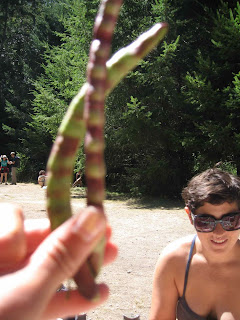Oh, remember when we went swimming at the lake and had a picnic and gave each other silly nicknames after different cheeses? Char brought some black-eyed peas, still in the pod, to share, and we ate them raw. I didn't know they spend their salad days in merry pink and green, and that only in their dessicated undead state do they become beige with black eyes. They were more tasty to look at than to eat raw, though, I'll admit.
 |
Beware, these peas are not really peas but beans. Somebody better tell Cook's Thesaurus. As cowpeas (a beany family), these Vigna unguiculata operate in that shadowy space of misrepresented legumes, standing shoulder-to-shoulder with the butterfly pea (Clitoria ternatea), chickpea (Cicer arietinum), pigeon peas (Cajanus cajan), and the winged pea (Lotus tetragonolobus). Thank you to the Library of Congress Everyday Mysteries patrol for informing us of this important distinction and also for telling us that:
As legumes they are extremely nourishing vegetables, both to people and to the soil. They are able to fix nitrogen, meaning nitrogen from the air is taken in by the plant and bacteria living in the roots convert it to a useable plant nutrient. Because of this process, nitrogen-fixing plants improve soil quality by adding nutrients back into the soil.
The "peas" bounced around in the topsoil of my belly as I let go of the rope swing and plunged into the cold cold water. I swam alone to the far end to investigate but got scared of lake monsters as I sank my toes into the muck around the tree roots and very soon turned back to join the others in the sun.








